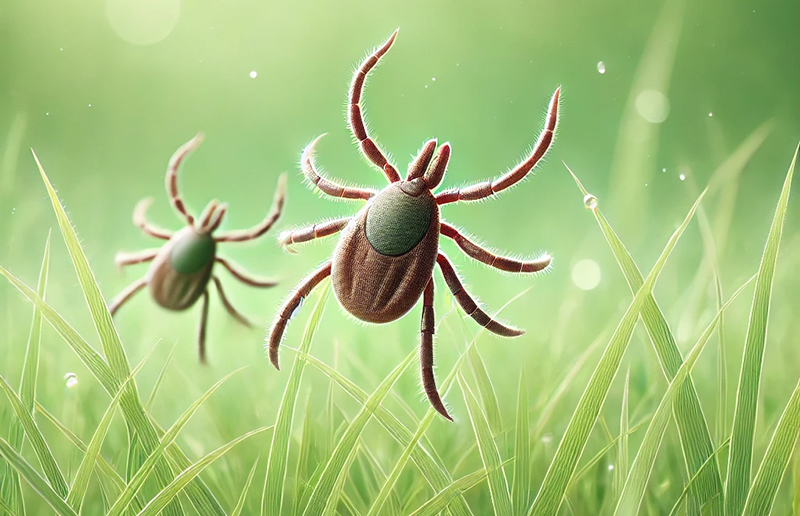Fleas on Dogs
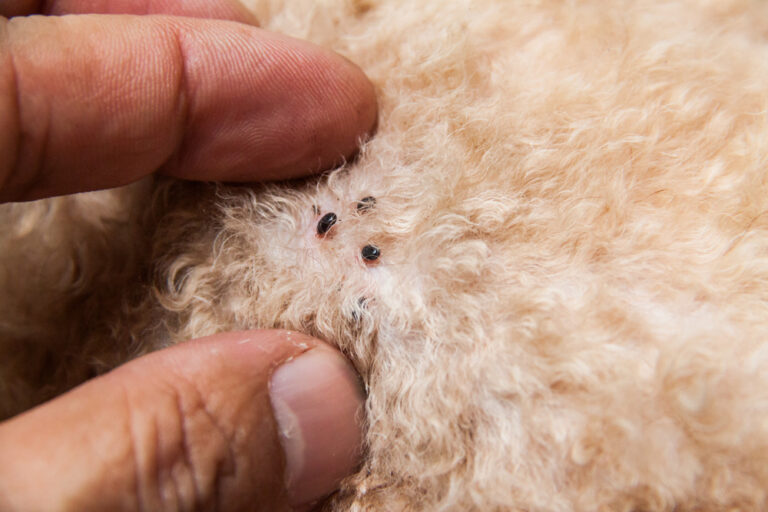
Image Credit: ThamKC, Shutterstock
Picture this: your furry bestie is living their best life, frolicking in the grass, chasing squirrels, and soaking up the sun. But suddenly, they start scratching like there’s no tomorrow, and you notice tiny, hopping invaders making themselves at home in your dog’s fur. Yep, you guessed it – fleas have crashed the paw-ty.
Fleas aren’t just a minor inconvenience; they’re like the uninvited guests who overstay their welcome and bring along their entire extended family. These minuscule menaces are more than just annoying; they’re downright bothersome for your pooch. Not only do they cause incessant itching and discomfort, but they can also lead to more serious issues like allergic reactions, skin infections, and even anemia in severe cases.
But how do these tiny troublemakers infiltrate your dog’s peaceful existence in the first place? Fleas are like little ninjas, sneaking into your home through cracks, crevices, and even hitching a ride on unsuspecting visitors (both human and furry). Once they set up camp on your dog, they waste no time multiplying like, well, fleas. In just a matter of days, a few fleas can turn into a full-blown infestation, leaving you and your pup scratching your heads (and everything else).
Overview of fleas and their impact on dogs
Scientific name: Ctenocephalides spp
Fleas are one of the most common parasites found in dogs. Flea bites can not only irritate your beloved pet, but they can also lead to the following diseases and conditions:
Flea allergy dermatitis
Dipylidium caninum (tapeworm)
Bartonellosis/Cat scratch disease
Anemia
Distribution and habitat: Fleas are found throughout Europe, America, and Australia. Indoors, they are commonly found in carpets, bedding (especially dog beds), and curtains. Outdoors, they prefer shaded, warm, and humid environments.
The flea life cycle
1) Eggs

Female adult fleas lay around 20 eggs at once on the fur of dogs, typically laying about 40 eggs per day. Depending on environmental conditions, eggs take 2 to 20 days to hatch.
2) Larvae

The larvae hatched from eggs primarily feed and grow on adult flea feces and other organic matter. Flea larvae are white, legless, and about ¼ inch in length. They undergo pupation within 5 to 20 days.
3) Pupa

This is the stage just before fleas become adults. The pupa remains in its cocoon until conditions are right for it to emerge as an adult (for a few days, weeks, or in some cases, months).
4) Adult
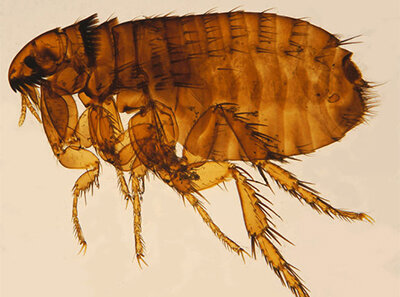
Once emerged from the cocoon, adult fleas must feed on blood within a few hours to survive. Afterwards, females begin reproducing and can lay eggs within just a few days.
Symptoms of a flea infestation
How do you check if your beloved dog has fleas? It’s clear that itching and inflammation from fleas can have significant long-term effects. Let’s look at some symptoms that can help determine if fleas are infesting your dog.
Persistent scratching
Just like humans, there might be reasons why your beloved dog is persistently scratching. If you notice your dog scratching excessively, it’s important to check for flea infestation. Pay particular attention if your dog is scratching around the head, neck, tail, or groin area.
Live fleas
Needless to say, the presence of even one live flea suggests the possibility of a significant infestation. If you find live adult fleas on your dog or in your home, it’s clear that there are not only other adult fleas but also potentially hundreds or thousands of eggs and larvae.
Flea feces
Flea feces is actually composed of digested blood from the pet they have fed on. This sign appears as tiny, pepper-like dirt under the pet’s fur, as well as on bedding and other areas around the home.
Hair loss
Fleas themselves don’t actually cause hair loss, but constant scratching, biting, or licking in one area can lead to hair loss in dogs. This is often observed around the base of the tail, shoulder blades, or behind the legs.
Dermatitis
When examining the skin around where the dog has been scratching, you may notice inflammation from bites. Small red bumps can form under the fur, and if the dog becomes hypersensitive to flea saliva, it can develop flea allergy dermatitis, leading to serious issues.
Gum Paleness
In the case of senior or young dogs, blood loss from flea bites can lead to anemia. Fleas can consume up to 15 times their body weight in blood, so if a dog is heavily infested, it can lose a significant amount of blood.
Flea-borne diseases
Flea Allergy Dermatitis
All flea bites will affect your pet in some way, but dogs may also exhibit specific allergic reactions to flea saliva known as Flea Allergy Dermatitis (FAD). This allergic reaction responds to specific proteins in the flea saliva released onto the skin. If a dog has FAD, even a single flea bite can cause weeks of itching, potentially causing significant stress to your pet.
Symptoms: Itching and discomfort are early signs of FAD, but other issues may arise such as scratching, licking, and continued biting. Watch out for signs of infection like rash or red bumps on the dog’s skin, skin bleeding or spotting, and hair loss around the affected area.
Dipylidium caninum (tapeworm)
Unlike other intestinal parasites, tapeworms infect dogs by ingesting fleas carrying tapeworm larvae. Tapeworm eggs attach to the intestines and develop into adult tapeworms, adhering to the intestinal wall. Preventing tapeworms before they infect the dog can be achieved by eliminating fleas.
Symptoms: Tapeworms typically cause no harm, and dogs tend not to show physical symptoms, although severe infestations can lead to weight loss. The most common sign is when a dog engages in “scooting,” trying to alleviate discomfort while passing dried tapeworm segments from the anus, leading to scratching or dragging their hindquarters along the ground.
Anemia
Anemia is not a disease per se, but rather a symptom that can become severe when fleas infest in large numbers. Anemia is a condition where there is a lack of sufficient red blood cells or hemoglobin in the bloodstream. While anemia can occur due to various reasons, continuous blood loss from flea bites, particularly in young or senior dogs, is one cause.
Symptoms: The most noticeable sign of anemia is pale pink or pale gums. Dogs may also show signs of fatigue, weakness, or depression. While these symptoms may be mild, if left untreated, they can progress to a more serious condition.
Cat Scratch Disease (Bartonellosis)
Bartonellosis is an infectious bacterial disease caused by Bartonella bacteria, which can affect various animals as pathogens. In humans, it’s known as Cat Scratch Disease, but it’s not necessarily caused by being scratched or bitten by a cat. This disease is transmitted to dogs by ingesting insects carrying the bacteria, including fleas, ticks, lice, and flies.
Symptoms: Not all dogs show symptoms, and it’s possible for the disease to only cause mild symptoms. However, it can lead to a wide range of serious symptoms such as lethargy, vomiting, fever, diarrhea, coughing, enlargement of the spleen and liver, inflammation of lymph nodes, myocardium, and brain.
Topical Flea Treatments
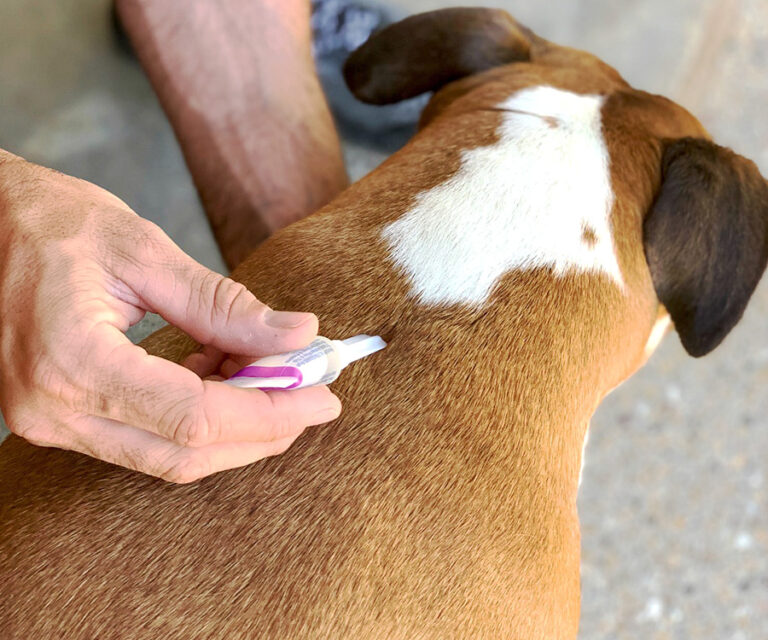
Image Credit: Hartz
When it comes to battling fleas, sometimes you need a frontline warrior – enter topical flea treatments. These handy solutions come in the form of spot-on treatments, sprays, and powders, providing targeted protection against those pesky parasites. In this section, we’ll explore the ins and outs of topical flea treatments, from how they work to their pros and cons.
Explanation of topical flea treatments
Topical flea treatments are a popular choice among pet owners for effectively combating flea infestations in dogs. These treatments typically come in the form of spot-on applications, where a small amount of liquid solution is applied directly to your dog’s skin, usually between the shoulder blades or along the back.
The active ingredients in topical flea treatments work to disrupt the flea life cycle, targeting adult fleas as well as eggs and larvae. When applied to your dog’s skin, the solution is absorbed into the oil glands and distributed throughout the body, providing long-lasting protection against fleas.
One of the key advantages of topical flea treatments is their ease of application. Most products come in pre-measured doses, making it simple to apply the correct amount to your dog’s skin. Additionally, topical treatments are often waterproof, meaning they remain effective even after bathing or swimming.
Another benefit of topical flea treatments is their versatility. Many products not only kill adult fleas but also target other parasites such as ticks, mosquitoes, and lice. This comprehensive approach to parasite control can help keep your dog safe from a range of pests.
However, it’s important to note that while topical flea treatments are generally safe and effective when used as directed, some dogs may experience mild skin irritation or sensitivity at the application site. It’s always a good idea to consult with your veterinarian before starting any flea treatment regimen to ensure it’s the right choice for your furry friend.
Overall, topical flea treatments offer a convenient and reliable solution for keeping your dog flea-free and comfortable. With regular use, you can protect your pup from the annoyance and health risks associated with flea infestations, allowing them to enjoy a happier, itch-free life.
Pros and cons of using topical treatments
Pros
- Effectiveness: Topical flea treatments are highly effective at killing adult fleas and preventing infestations. They work quickly to eliminate existing fleas and provide long-lasting protection against reinfestation.
- Convenience: Topical treatments are easy to apply and typically require only a single application per month. This makes them a convenient option for busy pet owners who want effective flea control without the hassle of daily or weekly treatments.
- Comprehensive Protection: In addition to killing fleas, many topical treatments also target other parasites such as ticks, mosquitoes, and lice. This comprehensive approach to parasite control helps keep your pointer safe from a variety of pests.
- Minimal Side Effects: When used as directed, topical flea treatments generally have minimal side effects. While some dogs may experience mild skin irritation or sensitivity at the application site, these reactions are typically rare and temporary.
Cons
- Potential Skin Sensitivity: Some pointers may experience skin irritation or sensitivity in reaction to the ingredients in topical flea treatments. This can manifest as redness, itching, or inflammation at the application site. If your pointer has sensitive skin or a history of skin allergies, it’s important to monitor them closely after applying the treatment.
- Residue: Topical flea treatments leave a residue on your pointer’s skin after application, which can feel greasy or oily. While this residue is necessary for the treatment to be absorbed into the skin, some dogs may find it uncomfortable or bothersome.
- Odor: Some topical flea treatments have a strong odor that may be unpleasant for both you and your pointer. While the odor typically dissipates within a few hours of application, it can be bothersome for sensitive noses.
- Limited Coverage: Topical flea treatments only provide protection against external parasites like fleas and ticks. They do not prevent or treat internal parasites such as heartworms or intestinal worms. If you’re looking for comprehensive parasite protection, you may need to use additional products in conjunction with topical flea treatments.
Oral Flea Medicines

Hassle-free flea control that’s as easy as giving your pointer a tasty treat. That’s the beauty of oral flea treatments. These convenient and effective solutions offer a hassle-free way to protect your pointer from flea infestations from the inside out. In this section, we’ll delve into the world of oral flea treatments, exploring how they work, their advantages, and why they might be the perfect choice for your pup.
How it works
Oral flea treatments work by delivering active ingredients into your pointer’s bloodstream through ingestion. Once ingested, these ingredients circulate throughout your dog’s body, targeting fleas when they feed on your pointer’s blood.
The active ingredients in oral flea treatments typically interfere with the flea’s nervous system, disrupting their ability to move, reproduce, and survive. This ultimately leads to the death of adult fleas and prevents flea eggs and larvae from developing into new adult fleas.
Unlike topical treatments that require direct application to your dog’s skin, oral flea treatments offer systemic protection, meaning they work from the inside out. This makes them an ideal choice for pointers who are difficult to handle or have sensitive skin.
Oral flea treatments are available in various forms, including chewable tablets, flavored liquids, and pills. Many dogs find these treatments palatable, making them easy to administer without the need for coercion or force.
One of the key advantages of oral flea treatments is their convenience. With just a single dose administered orally, you can provide your pointer with long-lasting protection against fleas for up to a month.
Additionally, oral flea treatments are often fast-acting, with some products starting to kill fleas within hours of ingestion. This rapid onset of action helps quickly eliminate existing flea infestations and provides immediate relief for your pointer.
Advantages and disadvantages of oral treatments
Advantages
-
Easy Administration: Oral flea treatments are often available in palatable forms such as chewable tablets or flavored liquids, making them easy to administer to your pointer without the need for coercion or force.
-
Systemic Protection: Oral flea treatments provide systemic protection against fleas, meaning they work from the inside out by circulating in your pointer’s bloodstream. This ensures comprehensive coverage and eliminates the need for direct application to your dog’s skin.
-
Convenience: With just a single dose administered orally, oral flea treatments offer convenient and long-lasting protection against fleas for up to a month. This eliminates the need for frequent reapplications and simplifies your flea control regimen.
-
Fast-Acting: Many oral flea treatments have a rapid onset of action, starting to kill fleas within hours of ingestion. This helps quickly eliminate existing flea infestations and provides immediate relief for your pointer from itching and discomfort.
-
No Residue: Unlike topical flea treatments, oral flea treatments do not leave a residue on your pointer’s skin, eliminating the risk of greasiness or discomfort after application.
Disadvantages
-
Potential Side Effects: Some pointers may experience mild side effects such as gastrointestinal upset (e.g., vomiting, diarrhea) or allergic reactions to the ingredients in oral flea treatments. It’s essential to monitor your dog closely after administration.
-
Limited Coverage: Oral flea treatments only target adult fleas and may not effectively eliminate other parasites such as ticks or mosquitoes. Additional products may be required for comprehensive parasite control.
-
Cost: Oral flea treatments may be more expensive than topical treatments or other flea control methods, depending on the brand and dosage regimen. This cost factor may be a consideration for pet owners on a tight budget.
-
Not Suitable for All Dogs: Some pointers may have difficulty swallowing chews or may refuse to take them due to taste preferences. In such cases, alternative flea control methods may be necessary.
Flea Collars
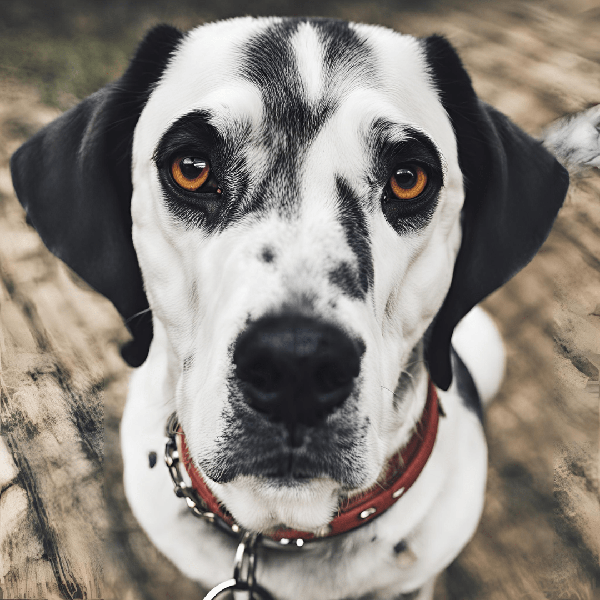
Looking for a hands-off approach to flea control for your pointer? Enter flea collars – the wearable warriors in the battle against those pesky parasites! Flea collars offer a convenient and long-lasting solution for protecting your pup from fleas, ticks, and other unwelcome guests. In this section, we’ll explore everything you need to know about flea collars, from how they work to their pros and cons.
Overview of flea collars and how they work
Flea collars are a popular and convenient method of flea control for dogs, offering continuous protection against fleas, ticks, and other biting insects. These collars are designed to be worn around your dog’s neck, where they release active ingredients that repel and kill fleas on contact.
Flea collars work through a process called diffusion, where the active ingredients contained within the collar gradually migrate through your dog’s skin and coat, forming a protective barrier against fleas and ticks. As your pointer moves and exercises, the friction and body heat generated help distribute the active ingredients more evenly, ensuring consistent and long-lasting protection.
The active ingredients in flea collars vary depending on the brand and formulation but commonly include insecticides such as imidacloprid, flumethrin, or deltamethrin. These ingredients target fleas and ticks by interfering with their nervous systems, ultimately leading to paralysis and death.
In addition to killing adult fleas and ticks, some flea collars also contain ingredients that disrupt the flea life cycle by preventing flea eggs and larvae from developing into adults. This comprehensive approach to flea control helps prevent reinfestation and keeps your pointer protected against fleas at all life stages.
Flea collars are typically water-resistant, meaning they remain effective even after your dog gets wet from swimming or bathing. However, prolonged exposure to water may reduce the collar’s effectiveness, so it’s essential to follow the manufacturer’s instructions regarding water exposure.
Pros and cons of flea collars
Pros
-
Long-lasting Protection: Flea collars provide continuous protection against fleas and ticks for several months, depending on the specific product. This eliminates the need for frequent reapplications and ensures your pointer remains protected around the clock.
-
Convenient: Flea collars are easy to use and require minimal effort to administer. Simply attach the collar around your pointer’s neck, and they’re good to go! There’s no need for messy applications or monthly treatments, making flea collars a hassle-free option for busy pet owners.
-
Water-resistant: Many flea collars are water-resistant, meaning they remain effective even after your pointer gets wet from swimming or bathing. This ensures uninterrupted protection against fleas and ticks, regardless of your dog’s activity level.
-
Wide Coverage: Flea collars provide comprehensive protection against a variety of parasites, including fleas, ticks, and sometimes mosquitoes. This multi-purpose approach to parasite control helps keep your pointer safe from a range of pests.
-
Cost-effective: In comparison to other flea control methods, such as topical treatments or oral chews, flea collars are often more cost-effective, especially considering their long-lasting protection.
Cons
-
Skin Irritation: Some pointers may experience skin irritation or sensitivity as a reaction to the collar material or the active ingredients. This can manifest as redness, itching, or inflammation around the neck area. It’s essential to monitor your dog closely after fitting the collar and consult with your veterinarian if any adverse reactions occur.
Limited Effectiveness: Flea collars may be less effective in heavily infested environments or for dogs with thick or long coats, as the active ingredients may not be evenly distributed throughout the fur. In such cases, additional flea control methods may be necessary for comprehensive protection.
Safety Concerns: There have been occasional reports of adverse reactions or incidents involving flea collars, such as accidental ingestion or entanglement. It’s crucial to follow the manufacturer’s instructions carefully and regularly check the collar for signs of wear or damage to ensure your pointer’s safety.
-
Odor: Some flea collars may emit a strong odor, which can be unpleasant for both your pointer and yourself. While the odor typically dissipates over time, it may be bothersome for sensitive noses.
Tips for Flea Prevention
Ready to take proactive steps to keep those pesky fleas at bay? In this section, we’ll share some invaluable tips and tricks for preventing flea infestations in your pointer. From simple household habits to proactive grooming routines, we’ve got you covered with everything you need to know to keep your pup itch-free and happy.
Practical advice for preventing flea infestations
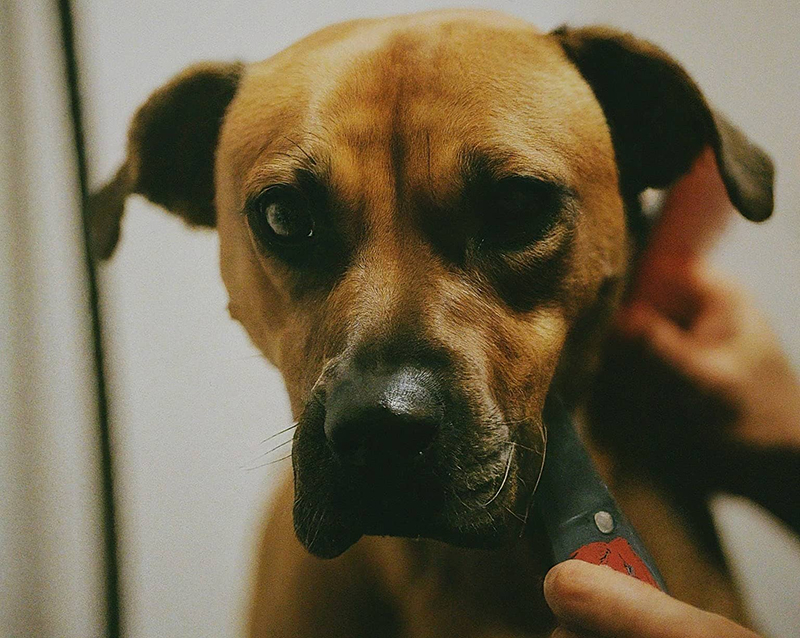
Here’s some practical advice for preventing flea infestations:
- Regular Grooming: Maintain a regular grooming routine for your pointer, including brushing their coat and inspecting their skin for any signs of fleas or flea dirt. Regular grooming helps remove fleas and prevents them from establishing infestations.
- Vacuuming: Vacuum your home frequently, paying special attention to areas where your pointer spends most of their time, such as carpets, rugs, and furniture. Vacuuming helps remove flea eggs, larvae, and adults from your home, reducing the risk of infestation.
- Wash Bedding: Wash your pointer’s bedding, blankets, and toys regularly in hot water to kill any fleas or eggs that may be present. This helps eliminate flea breeding grounds and prevents reinfestation.
- Yard Maintenance: Keep your yard tidy by mowing the lawn regularly and removing any debris or clutter where fleas and ticks may hide. Consider using outdoor flea control products or hiring a professional pest control service to treat your yard for fleas and ticks.
- Limit Exposure: Minimize your pointer’s exposure to areas where fleas are commonly found, such as wooded areas, tall grass, and marshy areas. Avoid walking your dog in these areas during peak flea season or use flea prevention products to protect them.
- Flea Collars or Spot-on Treatments: Use flea collars or spot-on treatments recommended by your veterinarian to provide continuous protection against fleas and ticks. These products contain active ingredients that repel and kill fleas, helping prevent infestations.
- Regular Veterinary Check-ups: Schedule regular veterinary check-ups for your pointer to monitor their health and discuss flea prevention options. Your veterinarian can recommend the most effective flea control products based on your dog’s age, health status, and lifestyle.
- Treat All Pets: If you have multiple pets in your household, ensure that all pets receive flea prevention treatments regularly. Even if one pet doesn’t show signs of fleas, they may still carry them and spread them to other pets.
- Be Vigilant: Keep an eye out for signs of fleas on your pointer, including excessive scratching, redness, or inflammation of the skin, and small black specks (flea dirt) on their fur. Early detection and treatment can help prevent flea infestations from becoming more severe.
Strategies for maintaining a flea-free environment

Here’s some practical advice for preventing flea infestations:
- Regular Grooming: Maintain a regular grooming routine for your pointer, including brushing their coat and inspecting their skin for any signs of fleas or flea dirt. Regular grooming helps remove fleas and prevents them from establishing infestations.
- Vacuuming: Vacuum your home frequently, paying special attention to areas where your pointer spends most of their time, such as carpets, rugs, and furniture. Vacuuming helps remove flea eggs, larvae, and adults from your home, reducing the risk of infestation.
- Wash Bedding: Wash your pointer’s bedding, blankets, and toys regularly in hot water to kill any fleas or eggs that may be present. This helps eliminate flea breeding grounds and prevents reinfestation.
- Yard Maintenance: Keep your yard tidy by mowing the lawn regularly and removing any debris or clutter where fleas and ticks may hide. Consider using outdoor flea control products or hiring a professional pest control service to treat your yard for fleas and ticks.
- Limit Exposure: Minimize your pointer’s exposure to areas where fleas are commonly found, such as wooded areas, tall grass, and marshy areas. Avoid walking your dog in these areas during peak flea season or use flea prevention products to protect them.
- Flea Collars or Spot-on Treatments: Use flea collars or spot-on treatments recommended by your veterinarian to provide continuous protection against fleas and ticks. These products contain active ingredients that repel and kill fleas, helping prevent infestations.
- Regular Veterinary Check-ups: Schedule regular veterinary check-ups for your pointer to monitor their health and discuss flea prevention options. Your veterinarian can recommend the most effective flea control products based on your dog’s age, health status, and lifestyle.
- Treat All Pets: If you have multiple pets in your household, ensure that all pets receive flea prevention treatments regularly. Even if one pet doesn’t show signs of fleas, they may still carry them and spread them to other pets.
- Be Vigilant: Keep an eye out for signs of fleas on your pointer, including excessive scratching, redness, or inflammation of the skin, and small black specks (flea dirt) on their fur. Early detection and treatment can help prevent flea infestations from becoming more severe.
Importance of regular flea control measures
Maintaining a flea-free environment on a regular basis:
- Regular Cleaning: Keep your home clean by vacuuming carpets, rugs, and upholstery regularly to remove flea eggs, larvae, and adults. Pay special attention to areas where your pets spend a lot of time, such as bedding, furniture, and pet crates.
- Wash Bedding and Linens: Wash your pet’s bedding, blankets, and other linens in hot water regularly to kill any fleas or eggs present. This helps prevent fleas from establishing infestations in your home.
- Treat Carpets and Upholstery: Consider using flea control products specifically designed for carpets and upholstery to kill fleas and prevent reinfestation. These products typically contain insecticides that target fleas at all life stages.
- Seal Entry Points: Seal any cracks, gaps, or entry points around doors, windows, and walls to prevent fleas from entering your home. This helps reduce the risk of flea infestations and keeps your home flea-free.
- Use Natural Repellents: Consider using natural flea repellents, such as diatomaceous earth or essential oils, to deter fleas from infesting your home. These natural products are safe for pets and humans and can be effective at repelling fleas when used properly.
- Outdoor Maintenance: Keep your yard tidy by mowing the lawn regularly and removing any debris or clutter where fleas and ticks may hide. Consider using outdoor flea control products or hiring a professional pest control service to treat your yard for fleas and ticks.
- Trim Vegetation: Trim shrubs, bushes, and vegetation around your home to reduce hiding spots for fleas and ticks. This helps prevent fleas from infesting your yard and reduces the risk of them entering your home.
- Use Pest Control Products: Consider using pest control products, such as flea traps or insecticide sprays, to target fleas in areas where they are commonly found. Follow the manufacturer’s instructions carefully and use caution when applying these products around pets and children.
- Regular Pest Inspections: Schedule regular pest inspections for your home to check for signs of fleas and other pests. Early detection and treatment can help prevent flea infestations from becoming more severe and difficult to control.


